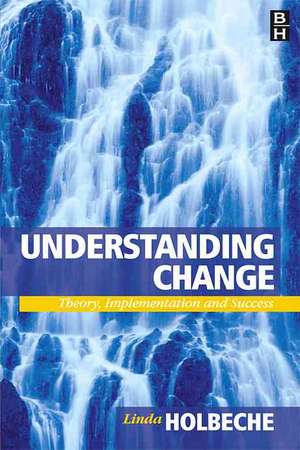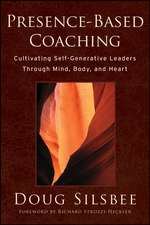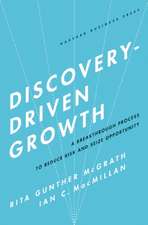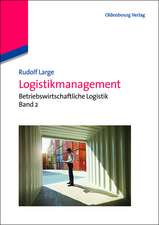Understanding Change
Autor Linda Holbecheen Limba Engleză Paperback – 20 oct 2005
Understanding Change: theory, implementation and success argues that strategic change in the new millennium will be geared increasingly to achieving sustainable high performance, rather than just short-term gains. Most theorists now agree that the real challenge of change lies in gaining employees" willingness to commit to the change effort. Change leaders at every level need to be able to understand the elements at work in any change process, and to use judgement about the style of leadership required to give the change effort the best chance of success.
Understanding Change: theory, implementation and success provides an overview of change and organizational theory, leading in particular to the author"s definition of the "input" elements of the high performance organisation, based on extensive research into UK and international organisations. It also contains a section looking at the management of change, with case studies illustrating approaches to managing change which are conducive to achieving sustainable high performance.
In her companion book, The High Performance Organization- creating dynamic stability, the author explores some of the "how to"s" of building an organizational culture which is supportive of high performance in today"s challenging environment.
| Toate formatele și edițiile | Preț | Express |
|---|---|---|
| Paperback (1) | 487.03 lei 6-8 săpt. | |
| Taylor & Francis – 20 oct 2005 | 487.03 lei 6-8 săpt. | |
| Hardback (1) | 1109.18 lei 6-8 săpt. | |
| Taylor & Francis – 15 apr 2016 | 1109.18 lei 6-8 săpt. |
Preț: 487.03 lei
Nou
Puncte Express: 731
Preț estimativ în valută:
93.22€ • 101.29$ • 78.36£
93.22€ • 101.29$ • 78.36£
Carte tipărită la comandă
Livrare economică 21 aprilie-05 mai
Preluare comenzi: 021 569.72.76
Specificații
ISBN-13: 9780750663410
ISBN-10: 0750663413
Pagini: 472
Dimensiuni: 156 x 234 x 27 mm
Greutate: 0.87 kg
Ediția:1
Editura: Taylor & Francis
Colecția Routledge
Locul publicării:Oxford, United Kingdom
ISBN-10: 0750663413
Pagini: 472
Dimensiuni: 156 x 234 x 27 mm
Greutate: 0.87 kg
Ediția:1
Editura: Taylor & Francis
Colecția Routledge
Locul publicării:Oxford, United Kingdom
Public țintă
HR Professionals and OD specialists; Change Agents; Line Managers; Students taking Chartered Management Institute units on Recruitment and Selection, Managing Performance. MBA and Post Graduate courses.Cuprins
Beyond ‘white water’; Drivers for change in the business environment; The impact of change on organizations; The impact of change on people; The evolution of organization theory; What is a high performance?; Change theory; Organizational culture; Creating a ‘change-able’ organization; Organizational development; Leaders as change agents; Leading transformational change; Communications in change; Radical change; Managing the people aspects of implementation; Transforming the Human Resources function; Conclusion: evaluating change.
Descriere
Change is now so commonplace that people no longer talk in terms of the "whitewater epoch". Every sector of the economies of the developed world has experienced huge swathes of change in the last decade of the twentieth century alone. Increased global competition, aided and abetted by technological advances, has led many organizations to seek to re-invent themselves in the hope of being able to survive and thrive. In mature sectors in particular, where the pace of consolidation is accelerating, organizations have had little option but to grow through acquisition or be absorbed. Whether the change is labelled "continuous process improvement", "restructuring", "downsizing" or re-engineering", to employees, change usually brings with it added pressures, job insecurity and a consequent loss of commitment to the organization.
Understanding Change: theory, implementation and success argues that strategic change in the new millennium will be geared increasingly to achieving sustainable high performance, rather than just short-term gains. Most theorists now agree that the real challenge of change lies in gaining employees" willingness to commit to the change effort. Change leaders at every level need to be able to understand the elements at work in any change process, and to use judgement about the style of leadership required to give the change effort the best chance of success.
Understanding Change: theory, implementation and success provides an overview of change and organizational theory, leading in particular to the author"s definition of the "input" elements of the high performance organisation, based on extensive research into UK and international organisations. It also contains a section looking at the management of change, with case studies illustrating approaches to managing change which are conducive to achieving sustainable high performance.
In her companion book, The High Performance Organization- creating dynamic stability, the author explores some of the "how to"s" of building an organizational culture which is supportive of high performance in today"s challenging environment.
Understanding Change: theory, implementation and success argues that strategic change in the new millennium will be geared increasingly to achieving sustainable high performance, rather than just short-term gains. Most theorists now agree that the real challenge of change lies in gaining employees" willingness to commit to the change effort. Change leaders at every level need to be able to understand the elements at work in any change process, and to use judgement about the style of leadership required to give the change effort the best chance of success.
Understanding Change: theory, implementation and success provides an overview of change and organizational theory, leading in particular to the author"s definition of the "input" elements of the high performance organisation, based on extensive research into UK and international organisations. It also contains a section looking at the management of change, with case studies illustrating approaches to managing change which are conducive to achieving sustainable high performance.
In her companion book, The High Performance Organization- creating dynamic stability, the author explores some of the "how to"s" of building an organizational culture which is supportive of high performance in today"s challenging environment.














